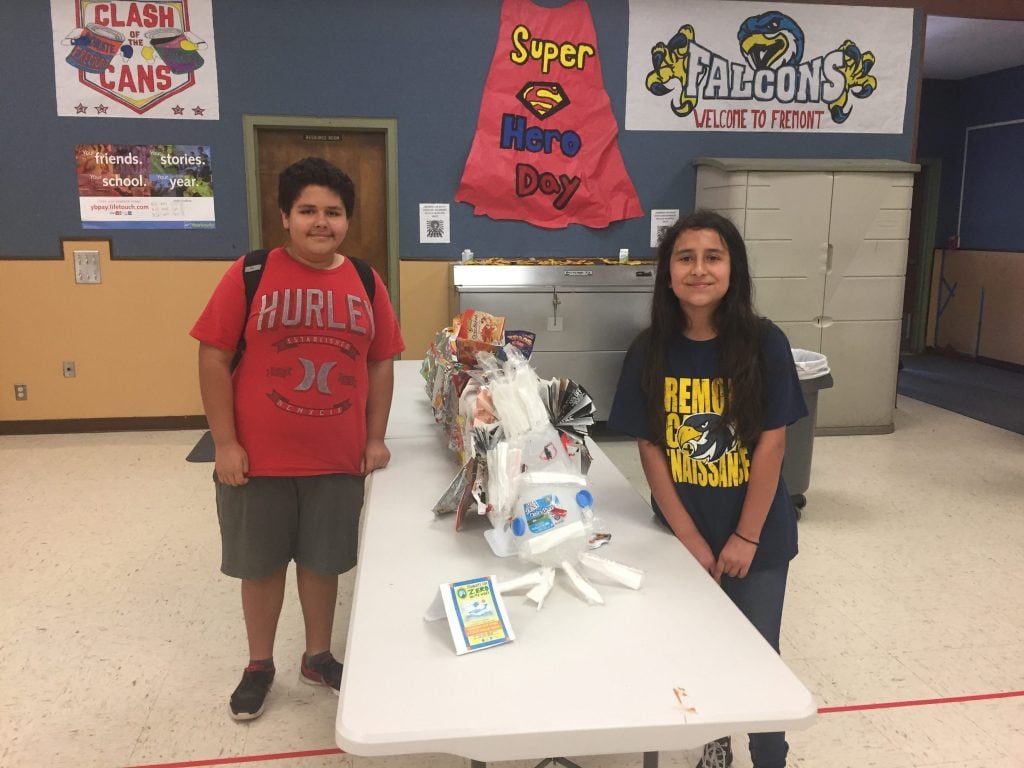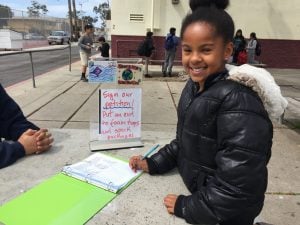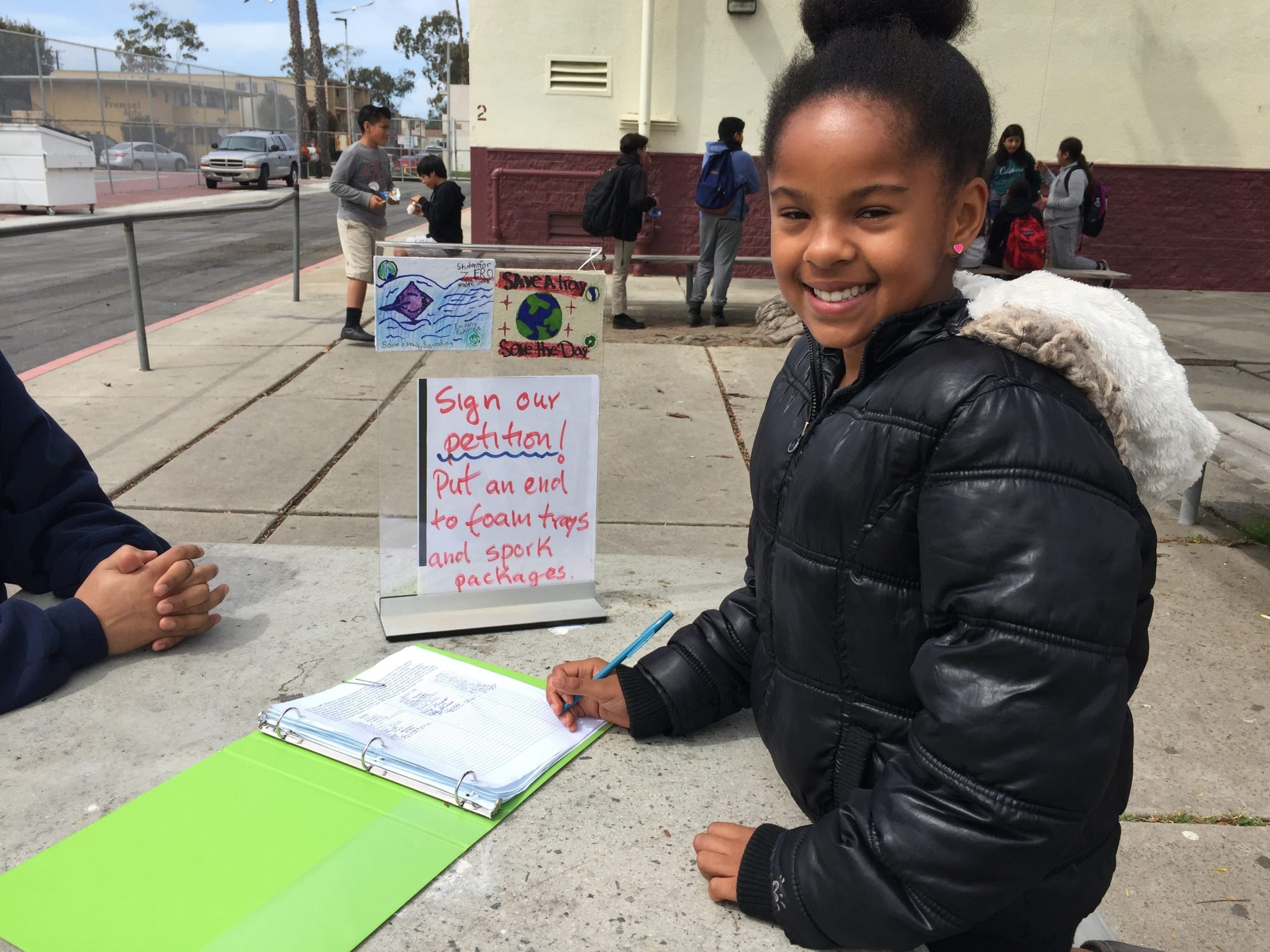Bow Seat Ocean Awareness Programs is a Massachusetts-based nonprofit that activates the next wave of ocean leaders through the arts, science, and advocacy. They believe that changing our world starts by inspiring and energizing young people to imagine a better future, and empowering them to create it themselves.
Bow Seat’s annual Ocean Awareness Contest challenges teens around the world to explore the connections between human activities and the health of our oceans through art, writing, film, and music. Many focus on plastic pollution and its impact on ecosystems, wildlife, and human health. Bow Seat also hosts the Marine Debris Creative Advocacy Competition, which challenges students to design and lead creative campaigns in their community that fight plastic pollution.
Nearly 7,000 young people worldwide have participated in Bow Seat programs since the organization’s launch in 2011. All under the age of 18, Bow Seat’s students are artists, activists, and environmental leaders who are making real changes for their local streets, rivers, and coasts. Meet some of them below! This community of young wavemakers spans almost every U.S. state and more than 60 countries, but all are passionate about using their creative voice to fight for our oceans. Here are some of their winners from 2017. Get inspired and get involved – Bow Seat’s 2018 program deadline is June 18th!
14-year-old Blue Brasher-Rues from Fayetteville, Arkansas
Blue was inspired to show her landlocked community that even though they are far from the coast, their actions impact the ocean. To raise awareness and concern about the issue of marine debris, Blue planned and curated a student art show and open mic. Blue partnered with the OMNI Center for Peace, Justice & Ecology to host the event, and secured donations and sponsorships from local businesses. The successful event connected hundreds of attendees with each other and the environment through visual art, poetry, music, and storytelling. Community members left with grocery bags made from recycled t-shirts and feelings of hope and possibility for creating a wave of positive change.
“I have always had a passion for protecting our Earth, and especially the water on it that gives life to all. We are not near the ocean, but our land and water are connected. We are a part of an ecosystem, and marine debris has a detrimental effect on our web of existence. It is the job of the people who know about an issue to spread knowledge and passion on that subject. I am ecstatic to know that I can do anything I set my mind to! And I want everyone in my generation knows that they can too.”
Fremont Middle School Enviro Club from Oxnard, California
Vanessa Garcia Torres, Isabel Arenas, Victor Godoy, Exivany Ramirez, and Amara Martinez

Enviro Club members created a plastic Quetzalcoatl – the Mesoamerican serpent revered as the giver of life and the God of intelligence, creation, and self-reflection – out of one day’s worth of the school’s discarded plastic trash. The Quetzalcoatl was displayed during the school’s Zero Waste Week, with a poster asking for self-reflection about how every individual can contribute to ending plastic pollution. During the campaign, the Enviro Club members collected 500+ signatures urging their School Board to adopt policies to end the use of polystyrene trays and spork packages and to replace these items with reusable options. The campaign culminated in presentations to the school district’s Director of Child Nutrition Services and the School Board, where the Quetzalcoatl served as the centerpiece during both meetings.

“Our school has been discarding approximately 500 polystyrene trays and spork packages with straws per day, in addition to hundreds of chip bags. These plastic pollutants either end up in the landfill or on the school’s field, where the mower turns them into plastic shrapnel. The wind blows it out onto the street, into the storm drain, and, ultimately, directly into the ocean, which is only three miles away.”
14-year-old Addie Farmer and Lainey Randall from Portland, Maine
Addie and Lainey launched a campaign to raise awareness of and inspire action around marine debris by introducing NOAA’s Marine Debris Tracker mobile application to their community. The duo set an ambitious goal for the community to collect and log 5,000 pieces of trash in approximately one month. Addie and Lainey conducted multiple outreach activities, including: communicating with their school community through posters, newsletters, and morning announcements; testifying before the Portland City Council; and presenting to the Gulf of Maine Research Institute. They were even featured on a local television news segment! Addie and Lainey concluded their campaign with a cleanup at East End Beach. They were joined by 30 volunteers who picked up litter and used the Marine Debris Tracker app to log in data. Together, they collected nearly 6,000 pieces of trash, bringing the month-long total to almost 8,000 items – 3,000 over their initial goal!
Soo Bin Cho, Cheyenne Bridge, Sage Nelson, and Lauren Richardson from Irvine/Newport, California

As interns for the city of Newport Beach’s Office of Natural Resources, students Soo Bin, Cheyenne, Sage, and Lauren researched the issue of marine debris, conducted local clean-ups, and analyzed their findings. The group wanted to show others how litter – and, in particular, plastic – has a direct impact on marine wildlife, so they created “Maurice,” a whale mural painted on a wooden board with a garbage bag for a stomach. They used Maurice for educational outreach activities and brought him to a local pier, where they encouraged visitors to pick up trash and deposit it in Maurice’s “stomach.” The team found that their interactive mural greatly enhanced their conversations about marine debris with beachgoers of all ages.
“The ocean holds significance in all of our hearts, and we wanted to do anything we could to help protect it. We were astounded by the amount of marine debris found at the beach and its impact on wildlife. We feel strongly about environmental advocacy and want to contribute to greater environmental awareness.”
Middle School Students at High Tech Middle North County from San Marcos, California
Middle school students involved in “The Ripple Effect” campaign led several projects to raise awareness about plastic pollution, including participating in beach cleanups, creating a children’s book about marine debris, building an informational website and social media campaign, hosting an exhibition for their school community, and raising money to purchase a water bottle filling station at their school. The highlight of their project was creating a life-size whale sculpture out of marine debris, now prominently displayed in their school. Thanks to their hard work, they were able to shift the culture of their school to be more focused on environmental conservation.
“The most meaningful part of the project was learning how quickly we are filling the ocean with plastic and just how much plastic exists in the ocean. We had no idea how it was affecting the animals in the ocean and the food that we eat. We also realized how easy it is to stop using plastic … every time we grab something that has plastic wrapping on it, we recognize that and prevent ourselves from using it, or use it much less. We are now more interested in helping others see the value in doing the same thing. We now see that one person or a small group can have an impact – and we believe this is a very important mindset for our generation to have.”
And because art is activism, too, here are some of the poets, painters, and filmmakers making waves of change!
14-year-old Dafne Murillo from Lima, Peru

“Plastic Whale”
“I’ve been involved in two annual beach cleanup projects, and I’ve been stunned by the countless bottles and plastic bags that are spread across the shoreline. This inspired my piece. My art is my version of the iceberg metaphor: people can only see the portion above the surface but are oblivious of the portion undersea. I feel this is the case in Peru (as in many other countries). People can appreciate our whales, yet fail to realize that by continuing to litter the sea with their plastic waste, they are responsible for the harm of marine wildlife through ingestion or entanglement.”
Lauren Krikorian from San Francisco, California
“As someone who lives and has grown up on the beach, plastics and the harm they can cause to marine life and the environment are a concerning and pressing issue for me. Whenever I walk on the beach I always pick up as much plastic as I can find to help preserve the beauty of the beaches. Seeing how much plastic gets stuck in ocean gyres and by dissecting albatross boluses, I have become more aware of what happens to the plastics that we use. I hope that my film will help someone else realize the dangers of plastic and take little steps to make their daily life more eco-friendly.”
Akhila Bandlora from Phoenix, AZ
i.
the girl with sea foam fingers writes letters
on napkins left on beaches like loose change,
words stumbling down staircases of five-seven-five haikus
— i want an ocean,
the one mama whispers of,
when she eats, sleeps, prays —
she ties them to the webbed foot of a seagull,
sends it off to the governor–
“the tide is coming.”
he laughs, the kind of laugh that corrodes,
shoos the seagull — lulls it to sleep with plastic wrappers and bottles —
throws the napkin away to land up exactly where the girl found it,
dips his pen into the seagull’s carcass to sign a bill
for a factory to dump their industrial waste into the ocean
— man made trashcan.
The girl’s eyes are seismic; the world shifts.
ii.
It’s 1972,
the year oysters pearl, fish jump, and crabs claw;
the girl trades her haikus for ballads, her flat chest
for fruit cup breasts, their apathy for her unrest
the sailors; they call her a woman.
she gargles the sea in her mouth to remember why she’s fighting,
pulls trash left on beaches and from washed up animal carnage,
dumps it on the governor’s desk–
“the tide is here.”
chants reduce, reuse, and recycle outside the homes of oil-guzzling men,
she leaks into classrooms, salt water ferments the walls,
teaches her children how to protect;
the world watches her,
until its eyes cataract,
teeth chip,
lips parch,
and ears burst.
And finally, it listens–
births the Marine Mammal Protection Act,
MPRSA, the ocean dumping act,
holds the UN Convention on the law of the sea–
All promises to defend.
she smiles,
whistles to the whoosh of the waves,
and shows her children how to protest —
The fight is not over.
iii.
It’s 2017,
where climate change is an alternative fact,
the ocean an afterthought instead of a forethought;
but it’s still her first thought.
her bones are soft like coral,
hair long like coast and gray like gravel,
voice throaty as a frog’s–
her battle ending,
the war still raging–
her children, we do not forget;
when our president pulls out of the Paris Agreement,
elects a denialist to run the EPA,
cuts its budget by thirty percent,
we grab conch shells and march on–
“the ocean is rising and so are we”–
she braids kelp through her hair,
washes her body with the sea,
tells us to never forget,
and we say we never will.
Qinlin Li from Southborough, Massachusetts
 “Bottled Home”
“Bottled Home”
“There are several factors that led to my passion for, and involvement in, sustainability, but I think my community has been my greatest impact, particularly my home country of China, and my own family’s involvement in and concern regarding pollution and sustainability. As a resident of China for the majority of my life, I have read about and seen firsthand how the environment has been polluted by the irresponsible behavior of people. I became interested in sustainability, hoping to do my part to raise sustainability awareness, by reducing my own waste of single-use products, reusing and recycling paper, and modeling so others would do the same. Through my artwork, I wish to raise an awareness of the threat of irresponsible plastic usage and inspire others to reduce their use of these synthesized materials.”
13-year-old Maxwell Sagermann from Santa Barbara, California

“Strangled Seas”
“I have always had a special spot in my heart for the sea, but over the years I have noticed definite changes in my local ecosystem, so I created this piece as a voice of my concern. When I started to work on the trash hand monster, I tried to use vibrant colors and large amounts of detail as I wanted it to be the focal point of the piece. The plastic industry also advertises their products with flashy colors to entice their consumers, but are secretly a monster in disguise.”
Inspiring, aren’t they? Check out Bow Seat’s website to see more amazing projects designed by young people who are making the oceans – and the world – a better place for all of us. A special thank you to the Bow Seat team for making this possible!



